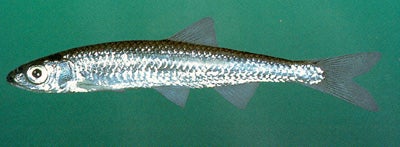SILVER SHINER
SCIENTIFIC NAME: Notropis photogenis
CHARACTERISTICS: Notropis photogenis has a terete, slightly compressed body with a medium-sized head and a pointed snout. Its oblique mouth extends rearward almost to the front of the eye. A broad, black lateral band extends from the gill opening to the caudal fin and expands into a horizontal oval spot at the caudal fin base. The lateral band is more intense on the caudal peduncle and fades toward the head; in live individuals this band is obscured by a bright silvery band. The lateral line scales are bounded above and below by pigment. Life colors of this species are generally olive on the back and silvery on the sides, the scales on the back being well outlined with pigment. Similar species include the rosyface shiner, N. rubellus, and the emerald shiner, N. athernoides, but both of these have a smooth dorsal edge to the anterior portion of the lateral band, whereas in N. photogenis this edge is bluntly saw-toothed. Additionally, a pair of large, dark crescents is present between to nostrils in N. photogenis. See cope (1865b) for original description.
ADULT SIZE: 2.4 to 3.9 in (60 to 100 mm)
DISTRIBUTION: A predominantly northern species, the silver shiner is found throughout the upper Ohio basin south to the Tennessee River drainage and is also found in western tributaries to Lake Erie. This is a rare occupant of Alabama waters. The last known specimens were collected from Shoal Creek at Goose Shoal, Lauderdale County, in 1983 and from the Tennessee section of the Elk River near Alabama (Feeman, 1987).
HABITAT AND BIOLOGY: Notropis photogenis can be found in large creeks and small rivers with clear water flowing over rock substrates. Trautman (1981) states that these shiners are most abundant in streams with deep, swift eddies and in flowing pools immediately below such riffles and that they typically avoid muddy bottoms and rooted aquatic vegetation. Etnier and Starnes (1993) report tuberculate individuals from late April through May in Tennessee. Diet likely consists of stream drift made up of terrestrial and aquatic insects. We have not collected this species often enough to learn much about its life history in Alabama.
ORIGINAL DESCRIPTION: The silver shiner was described by Cope in 1865.
ETYMOLOGY:
Notropis means keeled back.
Photogenis means light cheek.
The copyrighted information above is from Fishes of Alabama and the Mobile Basin.






